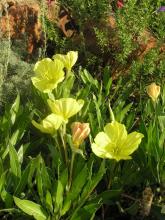
High Plains Gardening
The gardening website of the Texas High Plains Region

Oenothera macrocarpa, and O. missouriensis have been used interchangeably. Native over a wide range including the plains and wooded areas, carries the common name, Missouri evening primrose, bigfruit sundrops and Ozark Sundrops.
Yellow goblet shaped flowers on short reddish stems that become interesting elongated purple speckled seed capsules from mid spring to mid summer. Blooming slows during the heat of mid summer, but will pick up again as temperatures cool with late summer moisture. Evening primrose actually begins bloom an hour or two after dark and remains open until around 11 o’clock the next day, longer during cooler and cloudy summer days. The leaves are shiny gray green, narrow lanceolate or oblanceolate, with white veins. O. macrocarpa welcomes afternoon shade and it’s monthly allowance of water, but will do equally well in a medium water-use zone. O. macrocarpa can be seen flowering nicely in the red clay soils of Palo Duro Canyon.
Missouri evening primrose can be found growing in Palo Duro Canyon (third photo with red clay soil) and other natural areas; attracts moths, in our area the hawkmoth or sphinx moths, and hummingbirds. Small bees made stop to gather nectar, but generally not as pollinators.
O. macrocarpa 'Comanche Campfire' has a very pretty bluish-grey lance-like leaf with long blooming pale yellow flowers.There are several varieties or subspecies that exhibit differences in leaf color (usually more gray than green) and lighter yellow flower color. O. macrocarpa var. incana, Silver-leaved evening primrose is an attractive variety, as well as, with larger, but lighter goblet shaped flowers and narrower, shinier silver green leaves.
O. macrocarpa 'Comanche Campfire', a Great Plants of the Great Plains introduction in 2001, is another beautiful native selection. Smaller, lighter yellow in color, with smaller silver gray leaves.
Long blooming Missouri evening primrose is triply attractive: large yellow goblet shaped flowers turn to reddish-orange as they fade. Quickly the purple speckled sepals form the lance shaped seed pod. Sunny to sun/part shade low water-use bed, native plant bed. Xeristrip. Transition bed, prairie garden. Habitat garden.
Trim back if it sprawls too much. It's easy to save their seeds and pass them to friends. Plant seeds in the fall for spring flowers.